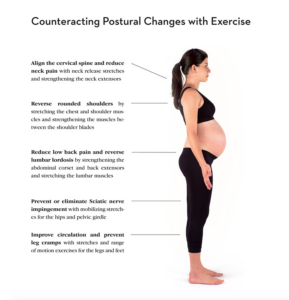
Pregnancy Posture and Your Aching Back!
Pregnancy is both a blessing and a challenge. The pregnant body is continuously changing, growing, and adapting for your baby’s needs. As your pregnancy advances, your posture naturally shifts. The weight that you will gain in pregnancy can impact normal body movements like sitting, standing, and changing positions.
Dr. Mariella Young, a chiropractor at Core Chiropractic and Wellness based in the Washington DC metropolitan area, focuses on pregnant patients and their ever-changing bodies. Dr. Young shares some reasons pregnancy affects your posture and some tips for maintaining good posture.
WHY PREGNANCY IMPACTS POSTURE
There are several reasons pregnancy can impact your posture. To start, you will carry more weight because of the baby and the changes in your body to support the pregnancy and baby. Additional weight specifically in the abdomen and breasts pulls the body forward placing extra strain on your pelvis and back.
This additional weight also impacts your legs and feet as they support your body differently when out of alignment. Swelling asymmetry in the body, also impacts the way you move.
As the baby grows there will be extra strain on your abdominal muscles. They can become weaker during pregnancy. As these muscles stretch you may lose strength and stability unless you are able to exercise them effectively. Weaker abdominals force your back to take on more of a weight-bearing role, possibly causing strain. Essentially, as your back tires to support your core and body more; lower back pain and strain become common.
During the course of pregnancy, your body will produce hormones that help the baby to drop into the pelvis and prepare your body for labor. These same hormones can make your joints looser and unstable if your muscles are unable to take up the slack. When your joints are less stable, it is more challenging for your spine to support your body as a whole. This can be a recipe for poor posture and possible injury.
Since looser joints make it harder to bend the knees and support the weight of the body, pregnant women tend to lock their knees and pivot their feet outwards to better withstand their changing weight. This can lead to long-term knee pain after your baby arrives.
Poor posture can also add pressure on your organs. For example, the way you lie down and sit can reduce circulation and put pressure on your organs. Positions you should avoid include
- Lying flat on your back
- Lying fully on your stomach
- Sitting without back support
- Sitting for more than 30 minutes at a time without switching leg positions

TIPS FOR IMPROVING POSTURE WHILE PREGNANT
It’s important to be mindful of your posture while pregnant. Here are several ways to improve or maintain a healthy posture during your pregnancy:
- Driving: Use a lumbar setting in your car to get into a comfortable driving position. Ideally, your knees should be evenly bent and your feet flat on the pedals. Avoid sitting with one leg bent or splayed out. Additionally, there should be a foot of space between your belly and the steering wheel. The seat belt should sit low across your hips and never on your belly.
- Sitting: Similar to driving, back support makes all the difference. Be sure you’re sitting all the way back in your chair, with your feet flat on the floor. Both your sit bones should be even on the surface. Do not cross your legs, rather cross at the ankles to keep your bottom evenly on the chair.
- Sleeping: Side sleeping is considered the ideal position when pregnant. If possible, sleep on your left side. Side sleeping minimizes pressure on your organs and sleeping on your left side maximizes blood flow through the placenta. Add a pillow between your bent knees for additional support (this keeps your sit bones square on the surface below them). You may also need to add a pillow under your belly as well to increase your comfort, making for fewer sleep disturbances.
- Standing: Try to keep your body weight from shifting too far forward, avoiding a swayback look. Keep your knees slightly bent, feet flat on the floor, and stand tall. Flat shoes or small heels are the best choices to reduce backpressure and to facilitate the proper alignment of your baby.
- Walking: Try to maintain a good vertical posture as you walk. Keep your body aligned from head to toe. Visualize a balloon and string rising from your head as a guide for your spine. Stay loose and relaxed.
- Working out: Let your body dictate your exercise. If you have any questions, ask your provider. Logically as the belly grows you may need to adjust and modify workout moves and positions. Some people are able to exercise normally until the last few weeks, while others need modifications early in pregnancy. For example, as your hips become looser during pregnancy, your balance may be affected. Your cycling may need to move to a stationary bike or running may become power walking.
Do note that proper spinal and pelvic alignment can have a profound impact on biomechanics which can make the difference between an ‘easy’ delivery and a more ‘difficult’ one. Asymmetry in the body or asymmetrical swelling can be indicative of misalignment in the body or with the baby.
As your baby grows, be sure to keep your posture and alignment in mind so that you stay as comfortable as possible. If you have any questions or experience any discomfort reach out to your therapist, chiropractor, or to Dr. Mariella Young at Core Chiropractic & Wellness.
